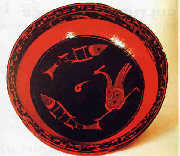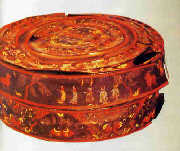 |
| Painted fish-pattern lacquer vessel, Qin Dynasty (221-206 BC) |
Over the longstanding Chinese history, numerous treasures and heritages have been left behind, among which the lacquer art is a brilliant one. China is the earliest country in the world using natural lacquer. In the early 1970s, archeologists unearthed a red lacquer wood bowl in an excavation in the Neolithic Hemudu remains in Yuyao, Zhejiang Province. It is estimated that the bowl was made 7,000 years ago, the oldest existing lacquer ware in the world.
Traditional Chinese lacquer art applies natural lacquer liquid from lacquer trees. China is abundant in lacquer resources. Lacquer trees in Mainland China are distributed in some
550 counties in 23 provinces.
Starting from red lacquer wood bowls and painted potteries in the Neolithic age, Chinese lacquer art enjoyed rapid development in the Warring Period (770-256BC) and the Han Dynasty (206BC-220AD), thanks to the upgraded productivity of the time.
According to historical documents, lacquer trees were widely planted during the Warring Period (770-256BC). Famous philosopher Zhuang Zi, founder of Daoism, worked as an official overseeing lacquer plantations for some time. At that time, lacquer was regarded as important as daily necessities such as linen, mulberry, fish and salt, and lacquer craftsmanship were remarkably raised. There were wood, bamboo and linen lacquer wares. Linen lacquerwork, not restrained from material sources, can be made in any shape. The improved craftsmanship gave rise to a multitude of lacquerwork varieties.
 |
|
Red lacquer bowl
|
The Warring Period (770-256BC) embraced the first peak of lacquer art development, which continued into the Western Han Dynasty (206BC-25AD). Unearthed objects indicate that lacquer wares in the Warring Period (770-256BC) had substantially surpassed the previous ages in terms of varieties, production output and scope of distribution. In the Warring Period (770-256BC), lacquer wares were used in every sphere of society, including daily utensils, music instruments, tomb wares and even weapons. People of Chu, living in Hubei, like red color and made a large number of red lacquer wares. Their lacquer works featured two basic colors, red and black, creating unique visual effect. Red and black lacquerworks have been characteristic of Chinese lacquer art.

